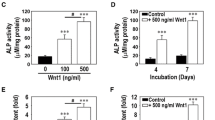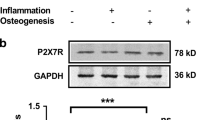Abstract
Recombinant COMP-Ang1, a chimera of angiopoietin-1 (Ang1), and a short coiled-coil domain of cartilage oligomeric matrix protein (COMP) can stimulate multiple cellular processes. Proliferative capacity of periodontal ligament (PDL) fibroblasts (PLFs) is important for maintaining PDL integrity and homeostasis. In this study, we explored whether exogenous COMP-Ang1 addition enhances proliferation of human PLFs and the cellular mechanisms therein. We initially isolated and characterized PLFs, where the cells showed highly positive staining for surface markers, CD90, CD105, and CD146. COMP-Ang1 treatment increased proliferation of PLFs by stimulating migration of cells into S and G2/M phases. This increase was coupled with decreased p21Cip and p27Kip levels and enhanced cyclin D1, cyclin-dependent kinase (CDK) 2, and CDK4 induction. Transfection with si-Tie2 near completely blocked COMP-Ang1-stimulated cell cycle progression in PLFs. Tie2 knockdown also inhibited COMP-Ang1-induced phosphorylation of mitogen-activated protein kinases (MAPKs). In addition, COMP-Ang1-mediated activation of Akt and c-Jun was suppressed by treating each of pharmacological inhibitors specific to phosphoinositide 3-kinase (PI3K) (LY294002 and Wortmannin) or MAPKs (PD98059, SB203580, and SP600125). Similarly, COMP-Ang1-mediated increases in DNA synthesis and cyclin D1 induction were prevented by treating inhibitor of MAPKs and PI3K or by c-Jun knockdown. These results suggest that COMP-Ang1 enhances survival and proliferation of human PLFs through the activation of Tie2-mediated signaling, where PI3K/Akt and MAPK-c-Jun signaling pathways act as downstream effectors. Collectively, COMP-Ang1 may be a useful as a stimulator of human PLFs and therefore improves PDL integrity and homeostasis.










Similar content being viewed by others
References
Nagatomo K, Komaki M, Sekiya I, Sakaguchi Y, Noguchi K, Oda S, Muneta T, Ishikawa I (2006) Stem cell properties of human periodontal ligament cells. J Periodontal Res 41:303–310
McCulloch CA, Bordin S (1991) Role of fibroblast subpopulations in periodontal physiology and pathology. J Periodontal Res 26:144–154
Sodek J, Limeback HF (1979) Comparison of the rates of synthesis, conversion and maturation of type I and type III collagens in rat periodontal tissues. J Biol Chem 254:10496–10502
Lekic P, McCulloch CA (1996) Periodontal ligament cell population: the central role of fibroblasts in creating a unique tissue. Anat Rec 245:327–341
Kim SY, Lee JY, Park YD, Kang KL, Lee JC, Heo JS (2013) Hesperetin alleviates the inhibitory effects of high glucose on the osteoblastic differentiation of periodontal ligament stem cells. PLoS One 8:e67504
Kook SH, Jeon YM, Park SS, Lee JC (2014) Periodontal fibroblasts modulate proliferation and osteogenic differentiation of embryonic stem cells through production of fibroblast growth factors. J Periodontol 85:645–654
Vogel G (2000) Cell biology. Stem cells: new excitement, persistent questions. Science 290:1672–1674
Wagers AJ, Weissman IL (2004) Plasticity of adult stem cells. Cell 116:639–648
Cho CH, Kammerer RA, Lee HJ, Steinmetz MO, Ryu YS, Lee SH, Yasunaga K, Kim KT, Kim I, Choi HH, Kim W, Kim SH, Park SK, Lee GM, Koh GY (2004) COMP-Ang1: a designed angiopoietin-1 variant with nonleaky angiogenic activity. Proc Natl Acad Sci USA 101:5547–5552
Jeong BC, Kim HJ, Bae IH, Lee KN, Lee KY, Oh WM, Kim SH, Kang IC, Lee SE, Koh GY, Kim KK, Koh JT (2010) COMP-Ang1, a chimeric form of angiopoietin 1, enhances BMP2-induced osteoblast differentiation and bone formation. Bone 46:479–486
Park BH, Yoon SJ, Jang KY, Kim MR, Lee HS, Kim KB, Park H, Lee SY, Park HS, Lim ST, Song KJ, Kim JR (2010) COMP-angiopoietin-1 accelerates bone formation during distraction osteogenesis. Bone 46:1442–1448
Kim S, Lee JC, Cho ES, Kwon J (2013) COMP-Ang1 accelerates chondrocyte maturation by decreasing HO-1 expression. J Cell Biochem 114:2513–2521
Kook SH, Lim SS, Cho ES, Lee YH, Han SK, Lee KY, Kwon J, Hwang JW, Bae CH, Seo YK, Lee JC (2014) COMP-angiopoietin 1 increases proliferation, differentiation, and migration of stem-like cells through Tie-2-mediated activation of p38 MAPK and PI3K/Akt signal transduction pathways. Biochem Biophys Res Commun 455:371–377
Lim SS, Kook SH, Bhattarai G, Cho ES, Seo YK, Lee JC (2015) Local delivery of COMP-angiopoietin 1 accelerates new bone formation in rat calvarial defects. J Biomed Mater Res Part A 103A:2942–2951
Kook SH, Son YO, Hwang JM, Kim EM, Lee CB, Jeon YM, Kim JG, Lee JC (2009) Mechanical force inhibits osteoclastogenic potential of human periodontal ligament fibroblasts through OPG production and ERK-mediated signaling. J Cell Biochem 106:1010–1019
Kook SH, Lee JC (2012) Tensile force inhibits the proliferation of human periodontal ligament fibroblasts through Ras-p38 MAPK up-regulation. J Cell Physiol 227:1098–1106
Kook SH, Son YO, Jang YS, Lee KY, Lee SA, Kim BS, Lee HJ, Lee JC (2008) Inhibition of c-Jun N-terminal kinase sensitizes tumor cells to flavonoid-induced apoptosis through downregulation of JunD. Toxicol Appl Pharmacol 227:468–476
Yasui T, Mabuchi Y, Toriumi H, Ebine T, Niibe K, Houlihan DD, Morikawa S, Onizawa K, Kawana H, Akazawa C, Suzuki N, Nakagawa T, Okano H, Matsuzaki Y (2016) Purified human dental pulp stem cells promote osteogenic regeneration. J Dent Res 95:206–214
Barry FP, Boynton RE, Haynesworth S, Murphy JM, Zaia J (1999) The monoclonal antibody SH-2, raised against human mesenchymal stem cells, recognizes an epitope on endoglin (CD105). Biochem Biophys Res Commun 265:134–139
Alvarez R, Lee HL, Wang CY, Hong C (2015) Characterization of the osteogenic potential of mesenchymal stem cells from human periodontal ligament based on cell surface markers. Int J Oral Sci 7:213–219
Melkerson-Watson LJ, Waldmann ME, Gunter AD, Zaroukian MH, Esselman WJ (1994) Elevation of lymphocyte CD45 protein tyrosine phosphatase activity during mitosis. J Immunol 153:2004–2013
Simmons PJ, Torok-Storb B (1991) Identification of stromal cell precursors in human bone marrow by a novel monoclonal antibody, STRO-1. Blood 78:55–62
Nagayasu-Tanaka T, Anzai J, Takaki S, Shiraishi N, Terashima A, Asano T, Nozaki T, Kitamura M, Murakami S (2015) Action mechanism of fibroblast growth factor-2 (FGF-2) in the promotion of periodontal regeneration in beagle dogs. PLoS One 10:e0131870
Yu Y, Bai F, Liu Y, Yang Y, Yuan Q, Zou D, Qu S, Tian G, Song L, Zhang T, Li S, Liu Y, Wang W, Ren G, Li D (2015) Fibroblast growth factor (FGF21) protects mouse liver against D-galactose-induced oxidative stress and apoptosis via activating Nrf2 and PI3K/Akt pathways. Mol Cell Biochem 403:287–299
Kim MS, Lee DY (2015) Insulin-like growth factor binding protein-3 enhances etoposide-induced cell growth inhibition by suppressing the NF-κB activity in gastric cancer cells. Mol Cell Biochem 403:107–113
Kim S, Lee JC, Cho ES, Kwon J (2013) COMP-Ang1 promotes chondrogenic and osteogenic differentiation of multipotent mesenchymal stem cells through the Ang1/Tie2 signaling pathway. J Orthop Res 31:1920–1928
Kim I, Kim HG, So JN, Kim JH, Kwak HJ, Koh GY (2000) Angiopoietin-1 regulates endothelial cell survival through the phosphatidylinositol 3-kinase/Akt signal transduction pathway. Circ Res 86:24–29
Joo HJ, Kim H, Park SW, Cho HJ, Kim HS, Lim DS, Chung HM, Kim I, Han YM, Koh GY (2011) Angiopoietin-1 promotes endothelial differentiation from embryonic stem cells and induced pluripotent stem cells. Blood 118:2094–2104
Liu XB, Jiang J, Gui C, Hu XY, Xiang MX, Wang JA (2008) Angiopoietin-1 protects mesenchymal stem cells against serum deprivation and hypoxia-induced apoptosis through the PI3K/Akt pathway. Acta Pharmacol Sin 29:815–822
Cho CH, Kim KE, Byun J, Jang HS, Kim DK, Baluk P, Baffert F, Lee GM, Mochizuki N, Kim J, Jeon BH, McDonald DM, Koh GY (2005) Long-term and sustained COMP Ang1 induces long-lasting vascular enlargement and enhanced blood flow. Circ Res 97:86–94
Jirawatnotai S, Aziyu A, Osmundson EC, Moons DS, Zou X, Kineman RD, Kiyokawa H (2004) Cdk4 is indispensable for postnatal proliferation of the anterior pituitary. J Biol Chem 279:51100–51106
Martin A, Odajima J, Hunt SL, Dubus P, Ortega S, Malumbres M, Barbacid M (2005) Cdk2 is dispensable for cell cycle inhibition and tumor suppression mediated by p27(Kip1) and p21(Cip1). Cancer Cell 7:591–598
Sherr CJ (1996) Cancer cell cycles. Science 274:1672–1677
Dzau VJ, Braun-Dullaeus RC, Sedding DG (2002) Vascular proliferation and atherosclerosis: new perspectives and therapeutic strategies. Nat Med 8:1249–1256
Sherr CJ, Roberts JM (1999) CDK inhibitors: positive and negative regulators of G1-phase progression. Genes Dev 13:1501–1512
Conqueret O (2003) New roles for p21 and p27 cell-cycle inhibitors: a function of each cell compartment? Trends Cell Biol 13:65–70
Ono K, Han J (2000) The p38 signal transduction pathway: activation and function. Cell Signal 12:1–13
Zhang W, Liu HT (2002) MAPK signal pathways in the regulation of cell proliferation in mammalian cells. Cell Res 12:9–18
Ryu CH, Park SA, Kim SM, Lim JY, Jeong CH, Jun JA, Oh JH, Park SH, Oh WI, Jeun SS (2010) Migration of human umbilical cord blood mesenchymal stem cells mediated by stromal cell-derived factor-1/CXCR4 axis via Akt, ERK, and p38 signal transduction pathways. Biochem Biophys Res Commun 398:105–110
Lee JC, Son YO, Pratheeshkumar P, Shi X (2012) Oxidative stress and metal carcinogenesis. Free Radic Biol Med 53:742–757
Peng SB, Peek V, Zhai Y, Paul DC, Lou Q, Xia X, Eessalu T, Kohn W, Tang S (2005) Akt activation, but not extracellular signal-regulated kinase activation, is required for SDF-1alpha/CXCR4-mediated migration of epithelioid carcinoma cells. Mol Cancer Res 3:227–236
Wang G, Ma N, Meng L, Wei Y, Gui J (2015) Activation of the phosphatidylinositol 3-kinase/Akt pathway is involved in lipocalin-2-promoted human pulmonary artery smooth muscle cell proliferation. Mol Cell Biochem 410:207–213
Vleugel MM, Greijer AE, Bos R, van der Wall E, van diest PJ (2006) c-Jun activation is associated with proliferation and angiogenesis in invasive breast cancer. 37:668–674
Acknowledgments
This research was supported by Basic Science Research Program through the National Research Foundation of Korea (KRF) funded by the Ministry of Science, ICT and future Planning (NRF-2013R1A2A2A01967207).
Author information
Authors and Affiliations
Corresponding author
Additional information
Shin-Saeng Lim and Sung-Ho Kook have contributed equally to this work.
Rights and permissions
About this article
Cite this article
Lim, SS., Kook, SH. & Lee, JC. COMP-Ang1 enhances DNA synthesis and cell cycle progression in human periodontal ligament cells via Tie2-mediated phosphorylation of PI3K/Akt and MAPKs. Mol Cell Biochem 416, 157–168 (2016). https://doi.org/10.1007/s11010-016-2704-3
Received:
Accepted:
Published:
Issue Date:
DOI: https://doi.org/10.1007/s11010-016-2704-3




